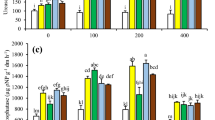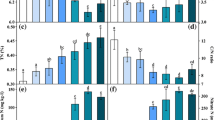Abstract
Oil spills are a significant stressor to coastal and maritime environments worldwide. The growth responses of Batis maritima and Avicennia germinans seedlings to weathered Deepwater Horizon oiling were assessed through a mesocosm study using a factorial arrangement of 4 soil oiling levels (0 L m−2, 1 L m−2, 2 L m−2, 4 L −m−2) × 3 tissue oiling levels (0% of stem height, 50% of stem height, 100% of stem height). Overall, growth metrics of B. maritima displayed much greater sensitivity to both tissue and soil oiling than A. germinans, which exhibited a relatively high tolerance to both routes of oiling exposure. Batis maritima in the 4 L m−2 soil oiling treatment demonstrated significant reductions in cumulative stem height and leaf number, whereas no significant effects of soil oiling on A. germinans were detected. This was reflected in the end of the study biomass partitioning, where total aboveground and live aboveground biomass were significantly reduced for B. maritima with 4 L m−2 soil oiling, but no impacts to A. germinans were found. Tissue oiling of 100% did appear to reduce B. maritima stem diameter, but no effect of tissue oiling was discerned on biomass partitioning, suggesting that there were no impacts to integrated growth. These findings suggest that B. maritima would be more severely affected by moderate soil oiling than A. germinans.







Similar content being viewed by others
References
Abramoff MD, Magalhães PJ, Ram SJ (2004) Image processing with ImageJ. Biophoton Intl 11:36–42
Alongi DM (2002) Carbon sequestration in mangrove forests. Carbon Manage 3:313–322
Alleman LK, Hester MW (2010) Refinement of the fundamental niche of black mangrove (Avicennia germinans) seedlings in Louisiana: applications for restoration. Wetlands Ecol Manage 19:47–60
Anderson CJ, Hess TA (2012) The effects of oil exposure and weathering on black-needle rush (Juncus roemerianus) marshes along the Gulf of Mexico. Marine Pollut Bull 64:2749–2755
Barbier EB, Hacker SD, Kennedy C, Koch EW, Stier AC, Silliman BR (2011) The value of estuarine and coastal ecosystem services. Ecol Monogr 81:169–193
Judy CR, Graham SA, Lin Q, Hou A, Mendelssohn IA (2014) Impacts of Macondo oil from Deepwater Horizon spill on the growth response of the common reed Phragmites australis: A mesocosm study. Marine Pollut Bull 79:69–76
Chindah AC, Braide SA, Amakiri J, Onokurhefe J (2011) Effect of crude oil on the development of white mangrove seedlings (Avicennia germinans) in the Niger Delta, Nigeria. Polish J Environ Stud 20:275–284
Coastal Protection and Restoration Authority of Louisiana (2017) Louisiana’s comprehensive master plan for a sustainable coast. Coastal Protection and Restoration Authority of Louisiana, Baton Rouge
Devaney JL, Lehmann M, Feller IC Parker JD (2017) Mangrove microclimates alter seedling dynamics at the range edge. Ecology 98:2513–22520
Duke NC (2016) Oil spill impacts on mangroves: recommendations for operational planning and action based on a global review. Marine Pollut Bull 109:700–715
Everard M, Jha RRS, Russell S (2014) The benefits of fringing mangrove systems to Mumbai. Aqua Conserv Marine Freshw Ecosyst 24:256–274
Getter CD, Baca BJ (1984) A laboratory approach for determining the effect of oils and dispersants on mangroves. Oil Spill Chemical Dispersants: Research, Experience, and Recommendations. ASTM International.
Getter CD, Ballou TG, Dahlin JA (1983) Preliminary results of laboratory testing of oil and dispersants on mangroves. Intl Oil Spill Conf 1983:533–533
Gorman D, Turra A (2016) The role of mangrove revegetation as a means of restoring macrofaunal communities along degraded coasts. Sci Total Environ 566- 567:223-229.
Grant DL, Clarke PJ, Allaway WG (1993) The response of grey mangrove (Avicennia marina (Forsk.) Vierh.) seedlings to spills of crude oil. J Exp Marine Biol Ecol 171:273–295
Hester MW, Spalding EA, Franze CD (2005) Biological resources of the Louisiana coast: Part 1. An overview of coastal plant communities of the Louisiana gulf shoreline. J Coast Res 134–145
Hester MW, Willis JM, Rouhani S, Steinhoff MA (2016) Impacts of the Deepwater Horizon oil spill on the salt marsh vegetation of Louisiana. Environ Pollut 216:361–370
Hughes AR, Cerbrian J, Heck K, Goff J, Hanley TC, Scheffel W, Zerebecki RA (2018) Effects of oil exposure, plant species composition, and plant genotypic diversity on salt marsh and mangrove assemblages. Ecosphere 9:e02207
Irwin RJ, Van Mouwerik M, Stevens L, Seese MD, Basham W (1997) Environmental Contaminants Encyclopedia Crude Oil Entry. National Park Service Water Resources Division, Water Operation Branch.
Kathiresan K, Bingham BL (2001) Biology of mangroves and mangrove ecosystems. Adv Marine Biol 40:81–251
Lee SY, Primavera JH, Dahdouh-Guebas F et al (2014) Ecological role and services of tropical mangrove ecosystems: a reassessment. Global Ecol Biogeogr 23:726–743
Lin Q, Mendelssohn IA (2012) Impacts and recovery of the Deepwater Horizon oil spill on vegetative structure and function of coastal salt marsh in the northern Gulf of Mexico. Environ Sci Technol 46:3737–3743
Lonard RI, Judd FW, Summy KR, DeYoe H, Stalter R (2017) The biological flora of coastal dunes and wetlands: Avicennia germinans (L.) L. J Coast Res 33:191–207
Lonard RI, Judd FW, Stalter R (2011) The biological flora of coastal dunes and wetlands: Batis maritima C. Linnaeus. J Coast Res 27:441–449
Mendelssohn IA, Hester MW, Sasser C, Fischel M (1990) The effect of a Louisiana crude oil discharge from a pipeline break on the vegetation of a southeast Louisiana brackish marsh. Oil Chem Pollut 7:1–15
Mendelssohn IA, Andersen GL, Baltz DM et al (2012) Oil impacts on coastal wetlands: implications for the Mississippi River delta ecosystem after the Deepwater Horizon oil spill. BioScience 62:562–574
Meudec A, Poupart N, Dussauze J, Deslandes E (2007) Relationship between heavy fuel oil phytotoxicity and polycyclic aromatic hydrocarbon contamination in Salicornia fragilis. Sci Total Environ 381:146–156
Michel J, Rutherford N (2013) Oil spills in marshes: planning & response considerations. Seattle: Office of Response and Restoration, National Oceanic and Atmospheric Administration, Seattle, WA and American Petroleum Institute, Washington, DC
Michel J, Owens EH, Zengel S, Graham A, Nixon Z, Allard T, Holton W, Reimer PD, Lamarche A, White M, Rutherford N (2013) Extent and degree of shoreline oiling: Deepwater Horizon oil spill, Gulf of Mexico, USA. PloS one 8(6):e65087
Nagelkerken IS, Blaber JM, Bouillon S et al (2008) The habitat function of mangroves for terrestrial and marine fauna: a review. Aquatic Botany 89:155–185
National Oceanic and Atmospheric Administration (2017) Largest oil spills affecting U.S. waters since 1969. National Oceanic and Atmospheric Administration. Available: www.noaa.gov. retrieved October 2020.
Nixon Z, Zengel S, Baker M, Steinhoff M, Fricano G, Rouhani S, Michel J (2016) Shoreline oiling from the Deepwater Horizon oil spill. Marine Pollut Bull 107:170–178
Pennings SC, Bertness MD (2001) Salt marsh communities Marine Commun Ecol 289–316
Pezeshki SR, Hester MW, Lin Q, Nyman JA (2000) The effects of oil spill and clean-up on dominant US Gulf coast marsh macrophytes: a review. Environ Pollut 108:129–139
Proffitt CE, Devlin DJ, Lindsey M (1995) Effects of oil on mangrove seedlings grown under different environmental conditions. Marine Pollut Bull 30:788–793
Rasser MK, Fowler NL, Dunton KH (2013) Elevation and plant community distribution in a microtidal salt marsh of the western Gulf of Mexico. Wetlands 33:575–583
Tunnell Jr JW, Hardegree B, Hicks DW (1995) Environmental impact and recovery of a high marsh pipeline oil spill and burn site, upper Copano Bay, Texas. International Oil Spill Conference 1:133–138. American Petroleum Institute
Turner RE, Rabalais NN, Overton EB et al (2019) Oiling of the continental shelf and coastal marshes over eight years after the 2010 Deepwater Horizon oil spill. Environ Pollut 252:1367–1376
Willis JM, Hester MW, Rouhani S, Steinhoff MA, Baker MC (2016) Field assessment of the impacts of Deepwater Horizon oiling on coastal marsh vegetation of Mississippi and Alabama. Environ Toxicol Chem 35:2791–2797
Acknowledgements
The authors are grateful to Dr. Quenton Fontenot for use of the Nicholls State University Farm Facility for housing the research.
Data availability
The datasets used and analyzed during the current study are available from the corresponding author on reasonable request.
Funding
This research was supported internally by the Applied Plant Science Laboratory at Nicholls State University.
Author information
Authors and Affiliations
Contributions
JW conceived the research; WH set up and executed the study and performed data collection; WH and JW equally contributed to statistical analysis and interpretation and the writing of the manuscript.
Corresponding author
Ethics declarations
Ethics approval and consent to participate
Not applicable.
Consent for publication
Not applicable.
Competing interests
The authors declare no competing interests
Additional information
Responsible Editor: Gangrong Shi
Publisher’s note
Springer Nature remains neutral with regard to jurisdictional claims in published maps and institutional affiliations.
Supplementary Information
ESM 1
(PDF 223 kb)
Rights and permissions
About this article
Cite this article
Heintz, W.J., Willis, J.M. Growth responses of Avicennia germinans and Batis maritima seedlings to weathered light sweet crude oil applied to soil and aboveground tissues. Environ Sci Pollut Res 29, 66148–66159 (2022). https://doi.org/10.1007/s11356-022-20458-w
Received:
Accepted:
Published:
Issue Date:
DOI: https://doi.org/10.1007/s11356-022-20458-w




